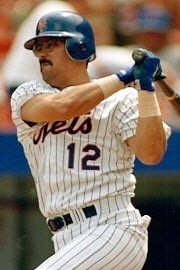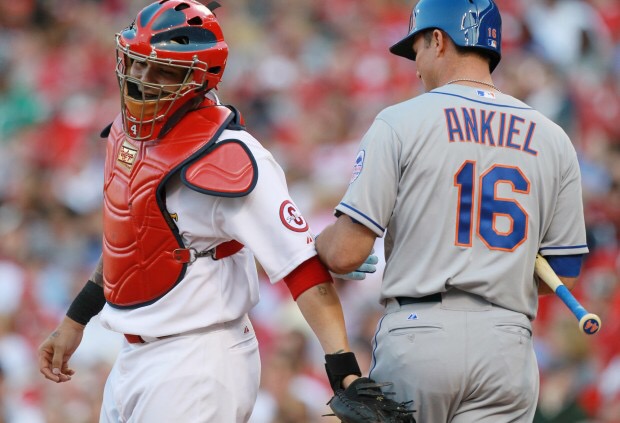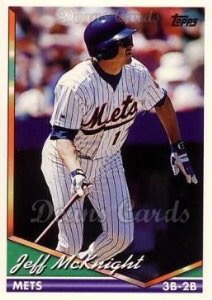Magic Number
After losing the 2000 World Series and a rough 2001 season, Steve Phillips decided the Mets needed to shift gear. He thought the Mets needed to be an offensive based team. He started with what seemed like the masterful Roberto Alomar trade. He also added Mo Vaughn (don’t trust the narrative, sadly the Mets won this trade) and Jeromy Burnitz via trade. Finally, the Mets signed Roger Cedeno. It was a disaster with the Mets finishing in last place with a 75-86 record.
All of the aforementioned players underachieved, none more so than Alomar. Part of the narrative behind Alomar’s season was the adjustment to New York and his rift with Rey Ordonez, who would be cast off to Tampa before the season. In his place, the Mets brought on a player approved by Alomar to play SS, today’s magic number 10, Rey Sanchez:
In theory, it made sense. You make a superstar like Alomar feel as comfortable as possible to get the most out of him. In practice, it failed. Alomar would hit .262/.336/.357 in 73 games for the Mets in 2003. With the Mets sitting at 36-47 and 16 games out of first place, the Mets traded Alomar. Sanchez couldn’t save him.
In fact, Sanchez needed to save himself. Sanchez had his career worst year in 2003. He hit .207/.240/.236. I think the Mets pitchers this year hit better than that. His play was so poor, he would only play in 56 games. Of course, he would leave the Mets and resurrect his career. Unfortunately, he couldn’t resurrect a Mets team that finished 66-95.
So Sanchez reminds us that there was a time that players didn’t always excel like Yoenis Cespedes when they came to the Mets. It’s also a reminder that it takes a special personality like Juan Uribe to come in and create a new clubhouse culture. Again, we learn how different and special this 2015 season is.
So with that, we all owe a hat tip to Rey Sanchez.

I so badly wanted to use number 11 to rant about how much I despised Razor Ramon Castro. However, since he was on good Mets teams, he doesn’t qualify.
That’s fine. I was able to find a truly despicable Met in Vince Coleman:
Coleman was a terrible Met, and if his Mets tenure was any indication, he was a terrible human being. It all came to a head in 1993, the only year Coleman wore 11, for a 59-103 Mets team.
That was the year Coleman crossed the line you do not cross. He attacked the fans. After a July game, he threw a M-100, which is used by the military to simulate grenades, towards a group of 200+ fans less than 30 feet away. It was described as nothing more than a prank. I guess it’s alright that he threw the firecracker because they were heckled after not stopping for autographs.
Unsurprisingly, there were fans injured. This included a two year old girl who suffered from second degree burns, a lacerated cornea, and an index finger injury. So no, I don’t agree with Coleman when he says he’s “no monster.” Who does this to people? By the way, where was Bud Selig, who was then acting commissioner? The lack of a suspension makes Roger Goodell look like he has a clue. Speaking of punishments, Coleman would serve no jail time, get 200 hours of community serve, and owe a small fine.
This was the lowlight of an otherwise dreadful 1993 season. It was a season that reminded you that sometimes your team is hard to root for when it has terrible people. It’s not only the baseball is bad, but the players are terrible as well. They don’t respect each other, the fans, or the game. They suck a the fun out of everything.
When I first thought of Coleman and the 1993 Mets, I was irritated. However, I began to think of the 2015 Mets and how they are the polar opposite in every way. This team is enjoyable. They play hard. They respect the fans. In fact, thinking of the 1993 team has made me appreciate this team all the more. Since that was the goal of this series, I guess mission accomplished.
I’m not offering a hat tip here to Coleman. He doesn’t deserve it. Let’s tip our caps to the 2015 Mets and hope they complete their mission to win the World Series. Lets Go Mets!

Yesterday, the problem was finding out who to pick for 14 in this series with the paucity of choices. Today’s selection was an abundance of good choices.
There was Roberto Alomar‘s disappointing tenure. I’m sure there are Mets fans that would’ve picked Willie Randolph, but he was decent with the Mets in the last year of a good career. Furthermore, I was higher on him as a manager than most people. I remember that Jeff Kent was hated by Mets fans, except the ones in my household.
When fans booed Kent, my Dad was baffled. When he saw Kent, he saw a terrific player. My Dad was right. Kent played well in his five years as a Met. Kent would win the 2000 NL MVP and finish his career with the most homeruns by a second baseman. However, all of that happened elsewhere. Why elsewhere? Well, the Mets made an idiotic trade including him and Jose Vizcaino for Carlos Baerga and today’s selection, Alvaro Espinoza:

Espinoza was not a great major league player, but truth be told, he was at his best in those 48 games with the Mets. So, why pick him? He was part of a trade that ditched a possible Hall of Fame second baseman for a player fading fast in Baerga. Neither player was of much help, especially in a 1996 season when the Mets finished 71-91.
Baerga’s numbers dropped steadily his three years in New York, and he couldn’t stay on second base. He would be gone before the glory years of 1999 and 2000, but you know who would reappear in 2000? Vizcaino. The man who put an end to Game 1 of the 2000 World Series. He was in that position due to Timo Perez‘s lack of hustle and Armando Benitez once again caving in from the pressure.
So I picked Esponiza more as a symbolic gesture as a reminder that the trade for the star usually doesn’t work in the Mets history. I think that reminder is quite aprospros this season.
With that in mind, please join me in offering a hat tip to Magic Number 12, Alvaro Espinoza.

Considering the fact that only three Mets have worn the number 14, I thought it might be hard to keep up my Magic Number series.
First and foremost, including Gil Hodges was a non-starter. Sure, he was an original Met. That meant he played on the worst team in MLB history. He also turned the franchise around as a manager and was in the dugout when the Miracle Mets won the 1969 World Series. He also died too young. Lastly, the number 14 was retired in his honor.
One of Hodges’ players on the ’69 Mets was Ron Swoboda. That was also a non-starter as he was a key member of the 1969 team. I know he wore 4 that year, but that was because Hodges took it back. In any event, the infusion of Swoboda would’ve been nonsense with this catch (1:24 mark):
That left Ken Boyer:

Now, Boyer is a borderline Hall of Famer. However, in the great tradition of Mets acquisitions, he was better elsewhere, much better.
Boyer might have been a five time Gd Gliver, an MVP, and seven time All Star, but he was an also-ran with the Mets. A career .287/.349/.462 hitter would hit .266/.304/.415 in 1966 and .235/.335/.355 in 1967 before he was traded to the White Sox. He was not Ken Boyer in Flushing.
In 1966, the Mets finished in ninth place (the penultimate place) with a 66-95 record. In 1967, the Mets finished in last place with a 61-101 record. Boyer was a sign of the rough times. assured, he could be in the Hall, but certainly not fur his play with the Mets.
So without further ado, let’s all offer a hat tip to Magic Number 14, Ken Boyer.

With yesterday’s win and the Nationals’ off day, the Mets magic number has been reduced to 16. In that vein, I present to you, Rick Ankiel:

Ankiel first presented himself into Mets’ lore by blowing up again in Game 2 of the 2000 NLCS. He would only go 0.1 innings with two wild pitches, three walks, and two earned. The Mets would go and win 6-5 en route to winning the series 4-1.
After a promising rookie season, it appeared that Ankiel was suffering from the yips or Steve Blass Disease. As he was athletic and could hit, the Cardinals made him a CF. In May 2013, he would sign with the Mets after he was released by the Astros.
The Mets signed him mostly because their poor CF options like Collin Cowgill weren’t working. Unfortunately, Ankiel seemed to stop taking HGH. He played in 20 games for the Mets hitting .182/.239/.364. That’s awful. That’s part of the reason the Mets finished the year with a 74-88 record.
However, as this was 2013, the year that Matt Harvey needed Tommy John surgery. It ended his 2013 season, and effective, his 2014 season. Things could not have seemed bleaker. It’s something to remember whe were enjoying this great ride.
Let’s all give Magic Number 16, Rick Ankiel, a hat tip.

Editor’s Note: If you’re looking for the current magic number, please click on the link here.
As per a suggestion from one of my loyal readers, my brother, I decided to have some fun with the Mets’ magic number. For this, I figured, I would have some fun with it because if you can’t have fun, what’s the point in doing a blog.
With the magic number being 17, I immediately thought of Keith Hernandez, but honestly that’s boring. Everyone points to him. I was his picture all over Twitter last night. However, I did get some inspiration from Keith. While he’s never actively sought for his number to be retired, he has grizzled at the players who have been assigned his number.
So with that in mind, I’ve decided to go with a lesser player to wear a particular number. Preferably, I’d like to stick with players I’ve seen. It’s even better if I can focus on players that played during losing seasons. I figure it’s a good reminder that seasons like this don’t come around all the time, and we should enjoy them when they come. So, without further ado, I present Jeff McKnight:
This is perfect. The Mets were terrible with a 59-103 record. It was a year after the Worst Team Money Can Buy. Also, let’s not forget those horrible underscore jerseys.
McKnight wasn’t a great player, certainly not good enough to wear Hernandez’s number. He was a Mets second round pick that never panned out. He was a career .233/.284/.304 hitter. He only wore 17 in 1993. I don’t do this to mock McKnight. It takes a lot just to make the big leagues.
However, it’s a reminder the Mets were terrible, and we should enjoy these years when they come. So I offer a hat tip to Jeff McKnight.


